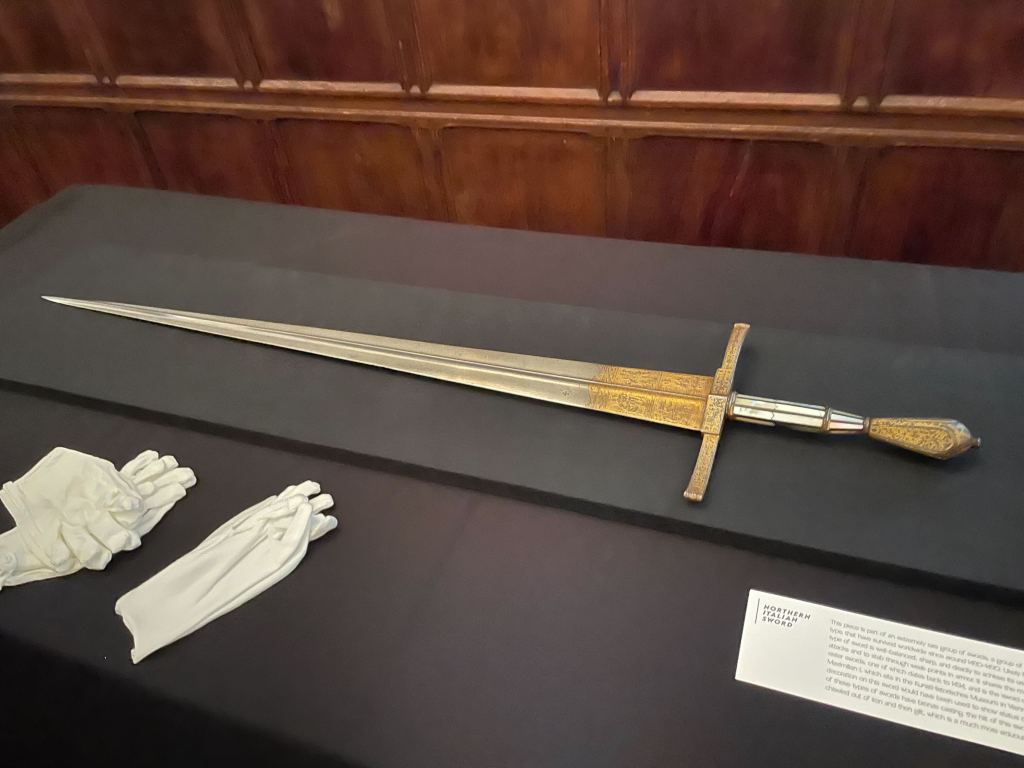By Francesca Aton
Editorial Assistant, Art in America
If you wanted the chance to wield a medieval sword in person, you might have missed your shot; however, there’s still an opportunity to experience these objects in augmented reality (AR) and to purchase them as NFTs.
As part of this week’s NFT.NYC conference, the world’s largest private collection of ancient arms and armor was on view Wednesday night alongside interactive NFT versions at the Explorer’s Club in New York’s Upper East Side.
Hailing from a collection with more than 6,000 artifacts from a collector who has remained anonymous, the ancient arms and armor on display included such pieces as the “lost” Harriet Dean Alexandria Sword, a 600-year-old Italian broadsword from Alexandria that went missing for 72 years, as well as an Ulfberht sword, of the same kind that was featured in the video game Assassin’s Creed Valhalla.
blogherads
.defineSlot( ‘medrec’, ‘gpt-dsk-tab-mid-article1-uid0’ )
.setTargeting( ‘pos’, [“mid-article1″,”mid”,”mid-article”,”mid-articleX”] )
.setSubAdUnitPath(“ros/mid-article”)
.addSize([[2,2],[300,250],[300,251]])
;
});
On the building’s second floor, attendants were eager to show off the ancient objects along with their digital counterparts. Handling the objects was encouraged with the use of white gloves.
I personally opted to test out—or haphazardly flail—the Dresden Rapier, a two-handed Renaissance-era sword with a decorated silver handle. Being able to handle the sword allowed me to feel the weight of it and see important details, such as the maker’s mark, up close. Those in attendance seemed more intrigued by opportunity to handle and inspect the ancient objects as opposed to their digital counterparts.
Placards next to each object explained general background history and importance, while an iPad standing alongside showed a digital rendering of the piece. Viewers could move the digital object around as they wished and zoom in to see minute details otherwise difficult to see to the naked eye.
A nearby QR code could also be scanned and, using AR technology, the object would appear as if floating in the room on the user’s phone. The user could also rotate the object to move it in different directions. While this seemed fun in theory, I had technical glitches that, in practice, kept me from participating.
Experiencing the objects up close and in-person, however, was certainly worth the trip.
The NFT versions of these objects were created by the organization the Knights Who Say Nah, who spearheaded the event and will use the proceeds to support museums and cultural institutions. Those who purchase the NFTs will have the option to vote on whether the physical pieces are donated or auctioned and how the proceeds will be used. The initial mint features PFP NFTs, representing different groups of ancient warriors, and will be followed by a release of 3D models, slated to debut later this summer.
“I wanted to share it,” Nick Lichey, the Knights Who Say Nah’s keeper of arms for the physical collection, told ARTnews of the impetus behind turning these objects into NFTs. “There is a fascination with these ancient items. I thought, as the NFT space was developing, how cool would it be to take one of these objects—whether they’re in a museum or a private collection—and introduce them and their stories to the world?”
Through the creation of these NFTs, the group is hoping “to create this bridge where people who do love Assasin’s Creed or play in this world can learn more about the museum side of things,” said Lichey. “If the stories don’t stay alive from these old cultures, then it’s as if these cultures didn’t exist.”
Exposure, however, isn’t the project’s only aim.
“Museums don’t have a ton of financial resources. Our goal is to raise money to help them with repatriation or the buying of objects,” Lichey continued. “We’re using NFTs to buy objects out of the private collection and put them into the public.”
At the event, a $10,000 donation was made to the Worcester Art Museum’s arms and armor department. Additionally, one object was slated to be donated to the Metropolitan Museum of Art in New York and another to the Art Institute of Chicago.
“I just couldn’t believe the level of detail that you could actually get from these models,” Jeffrey L. Forgeng, curator of arms and armor and Medieval Art at the Worcester Art Museum, told ARTnews. “You can zoom in on them and see surface details—precisely the sort of things that I look at when I’m looking at an object: the blemishes, the repairs, odd rivets, little holes.”
The introduction of this technology opens up new ways of exploring the ancient world, he added.
“We want visitors to come in and kind of do what curators and conservators do—look at the objects really closely and ask questions about objects from up close,” Forgeng said. “With something like this, we can really get them to do that. They can’t handle the actual objects; they are too precious and too fragile.”
Both Lichey and Forgeng spoke of the opportunity to use this technology to create 3D printed models—a move that could allow visitors to handle object replicas and could further accessibility efforts both online and within museums.
The World's Premier Art Magazine since 1913. Subscribe today and save up to 33%!
Sign Up for our Newsletters
Get our latest stories in the feed of your favorite networks
We want to hear from you! Send us a tip using our anonymous form.
Subscribe to our newsletters below
ARTnews is a part of Penske Media Corporation. © 2022 Art Media, LLC. All Rights Reserved.


